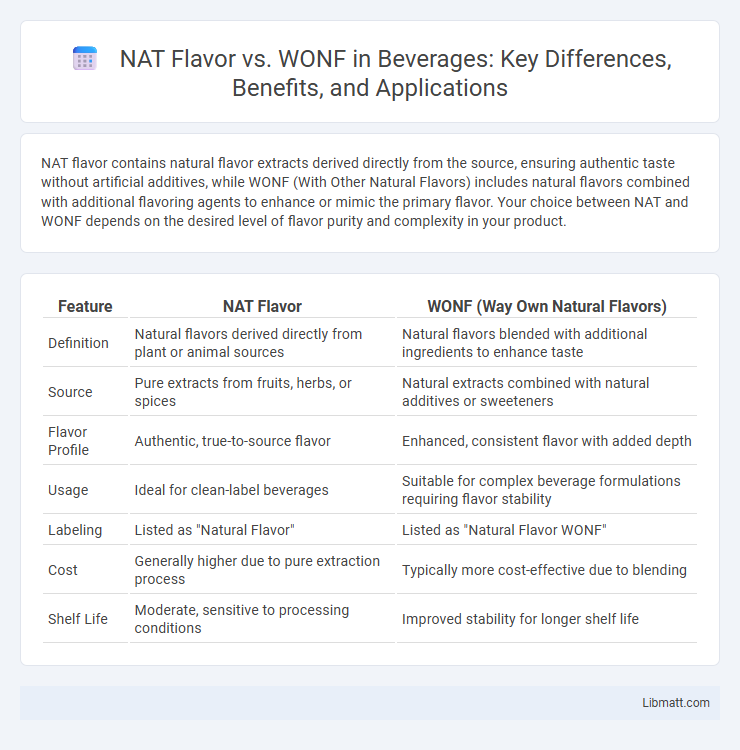NAT flavor contains natural flavor extracts derived directly from the source, ensuring authentic taste without artificial additives, while WONF (With Other Natural Flavors) includes natural flavors combined with additional flavoring agents to enhance or mimic the primary flavor. Your choice between NAT and WONF depends on the desired level of flavor purity and complexity in your product.
Table of Comparison
| Feature | NAT Flavor | WONF (Way Own Natural Flavors) |
|---|---|---|
| Definition | Natural flavors derived directly from plant or animal sources | Natural flavors blended with additional ingredients to enhance taste |
| Source | Pure extracts from fruits, herbs, or spices | Natural extracts combined with natural additives or sweeteners |
| Flavor Profile | Authentic, true-to-source flavor | Enhanced, consistent flavor with added depth |
| Usage | Ideal for clean-label beverages | Suitable for complex beverage formulations requiring flavor stability |
| Labeling | Listed as "Natural Flavor" | Listed as "Natural Flavor WONF" |
| Cost | Generally higher due to pure extraction process | Typically more cost-effective due to blending |
| Shelf Life | Moderate, sensitive to processing conditions | Improved stability for longer shelf life |
Introduction to NAT Flavor and WONF
NAT flavor refers to the natural flavoring derived directly from the named source, ensuring authenticity and traceability in food and beverage products. WONF (With Other Natural Flavors) indicates a combination of natural flavors alongside additional natural flavoring agents, creating a blended taste profile. These distinctions impact labeling transparency, regulatory compliance, and consumer perception of ingredient purity.
Definitions: What Are NAT Flavor and WONF?
NAT flavor (Not From Concentrate) refers to fruit juice made directly from freshly squeezed fruit without concentration or reconstitution, preserving natural flavors and nutritional content. WONF (With Other Natural Flavors) indicates juice enhanced with natural flavors derived from sources other than the primary fruit, ensuring consistent taste and aroma. Both terms are regulated by food labeling standards to inform consumers about juice authenticity and flavor composition.
Regulatory Framework: NAT Flavor vs WONF
NAT Flavor (Natural and Artificial Flavor) and WONF (With Other Natural Flavors) are both defined under FDA labeling regulations but differ in ingredient composition and transparency. NAT Flavor requires flavoring substances derived predominantly from natural sources, whereas WONF allows a mixture including natural flavor extracts combined with other natural components, offering broader formulation flexibility. Understanding the regulatory framework ensures accurate labeling compliance, as NAT Flavor labels emphasize natural chemistry while WONF encompasses more complex blends within FDA guidelines.
Key Ingredients: Comparing Formulation Approaches
NAT flavor typically relies on natural extracts and essential oils derived from fruits, herbs, or spices, ensuring a composition closer to the original raw ingredients. WONF (With Other Natural Flavors) combines primary natural extracts with additional natural flavor compounds, which may be sourced from various plant materials to enhance or modify the taste profile. Understanding these formulation approaches helps you choose the right product based on ingredient transparency and flavor authenticity.
Sensory Profiles: Taste and Aroma Differences
NAT flavor presents a fresh and vibrant sensory profile with pronounced fruity and floral aroma notes, often highlighting citrus and tropical fruit characteristics. WONF (Whole Orange Not From Concentrate) delivers a richer, more authentic orange essence with natural sweetness and zesty undertones, exhibiting a balanced aroma complexity resembling fresh-squeezed orange juice. The taste of NAT flavor tends to be brighter and more concentrated on specific fruit notes, while WONF offers a smoother, fuller flavor experience with a natural mouthfeel.
Labeling Requirements and Consumer Transparency
NAT (Not from Concentrate) juice must be clearly labeled to inform consumers that it is made directly from squeezed fruit without concentration, emphasizing product purity and natural processing. WONF (With Other Natural Flavors) juice requires labeling that discloses the addition of external flavorings, ensuring transparency about potential flavor modifications. Understanding these labeling distinctions helps Your purchase decisions by clarifying product contents and adherence to regulatory standards for accurate consumer information.
Cost and Sourcing Considerations
NAT flavor, derived from natural essential oils and often more concentrated, typically incurs higher costs due to complex extraction processes and limited raw material availability. WONF (With Other Natural Flavors) blends natural extracts with additional natural ingredients, offering more flexible sourcing options and generally lower production expenses. Your choice between NAT flavor and WONF depends on balancing budget constraints with ingredient sourcing reliability and desired flavor purity.
Market Trends Influencing NAT Flavor and WONF
Market trends show increasing consumer demand for natural and clean-label products driving growth in NAT flavor and WONF usage. NAT flavor, derived from natural sources with minimal processing, appeals to health-conscious buyers prioritizing authenticity, while WONF offers versatile flavor enhancement with cost efficiency. Your product development can benefit from balancing these trends to meet evolving preferences for transparency and sensory experience.
Applications in Food and Beverage Products
NAT flavor, known for its natural extraction methods, is widely used in food and beverage products to enhance authentic taste profiles and maintain clean-label standards. WONF (Wine of Natural Flavor) offers concentrated flavor profiles often utilized in beverages to deliver consistent taste intensity and mask batch variations. Both NAT flavor and WONF play critical roles in product formulation, influencing sensory qualities and consumer acceptance in processed foods and drinks.
Future Outlook: Innovations in Flavor Development
NAT flavor and WONF (Without Natural Flavors) represent evolving trends in the flavor industry with distinct future outlooks driven by consumer demand for transparency and natural ingredients. Innovations in flavor development focus on enhancing authenticity in NAT flavors through advanced extraction technologies and biotechnological methods, while WONF compositions continue to leverage complex blending techniques to mimic natural profiles without specifying individual components. Emerging research in flavor encapsulation and synthetic biology promises to further refine both categories, enabling sustainable production and improved sensory experiences in food and beverage applications.
NAT flavor vs WONF Infographic

 libmatt.com
libmatt.com